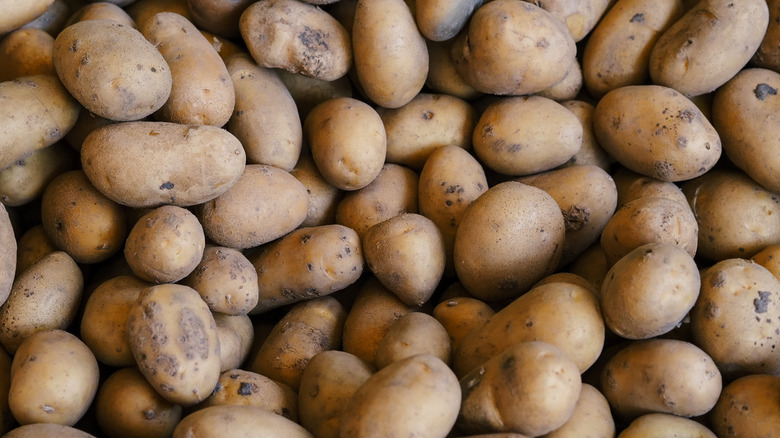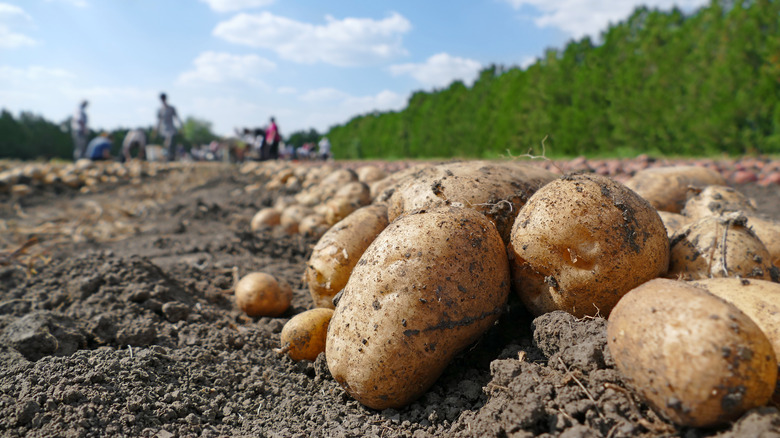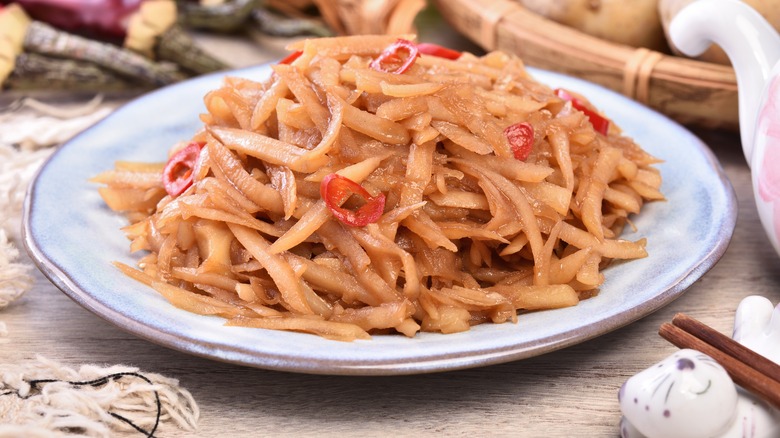The Country That Produces The Most Potatoes
Looking at cuisines around the world, you might assume that potato-loving countries like Russia or the United States are neck-and-neck when it comes to production. After all, spuds account for a $100.9 billion industry in the U.S. (per the National Potato Council), and mashed potatoes are practically our national side dish come Thanksgiving. Or maybe, knowing that South America domesticated the tuber before the food spread to farmers around the world, you figured Peru holds the lead.
However, if you get down to the meat and potatoes of it all, none of those countries hold a candle to the world's top potato producer. In addition to claiming the titles of biggest egg producer and top strawberry producer, China also grows the most spuds. Its farms put out nearly 92 million metric tons of the vegetable per year (via World Population Review). That's practically double the runner-up, India's, roughly 50 million metric ton output.
China took the global lead in 1993, outpacing European countries, and it has steadily increased production ever since. The trend reflects a growing prioritization of the crop in Asia, as well as Africa, in recent years. In 2021, China was responsible for approximately 25% of the world's rice and potatoes, and, as a whole, Asia was credited with 53% of the world's production that year (per Food and Agriculture Organization of the United Nations).
China's relationship with potatoes
The Dutch brought potatoes to China in the 1600s, but the vegetable was less popular than other starches. It wasn't until the 2010s that the country began to prioritize the food as a solution to potential future famines or food insecurity, naming it a staple food alongside other important grains like rice and wheat in 2015. This is because potatoes are a high-yield crop. They adapt to the weather extremes of climate change, grow in every region in the country, and are packed with nutrients like vitamin C. As such, China views production as a tactic to reduce reliance on imports and meet the needs of its growing population.
According to a 2021 article published in Nature Food, the push also has the potential to make China's agriculture industry more sustainable, as shifting from grains to tubers could reduce land use and cut greenhouse gas emissions by 17-25%. Plus, farmers can grow it in fallow rice fields for extra income, making it an enticing crop for established businesses. The only thing holding the tuber back is its reputation.
During times of historic famine, including China's great famine from 1959 to 1961, people turned to potatoes. As a result, some older cooks are reluctant to serve up a plate of bad memories. Households also treat the starch as a vegetable, and serve it alongside filling cereal and grain-based foods like rice and noodles. These factors leave the potato underutilized, considering the country's production prowess — for now.
Spud consumption today and in the future
You may wonder what exactly happens to those millions of tubers. Of course, some people are unencumbered by the food's history and eat them fresh. Potatoes shine in a spicy and sour shredded potato stir-fry, a less globally-known dish from Sichuan, that showcases the starch's firmer side. Others use spuds as animal feed, or export them in fresh or preserved forms to potato-loving countries.
Overall, however, consumption is an area where other countries have China beat, depending on how you look at it. When it comes to per capita consumption of the food — meaning the average quantity eaten per person — Belarus, Ukraine, Kazakhstan, Russia, and Poland far outpace the nation (per World Population Review).
China's industry experts aim to restore its global lead in all things tuber, which means it's taking aim at its farming and processing practices. Potato industry members are working hard to popularize spud varieties suited to frozen french fries — and convince home cooks, not just restaurants, to actually make them. Manufacturers are also expanding facilities and tasking food scientists with using potato starch in everything from bread to noodles. Researchers are even investigating non-food uses and working on plastic packaging alternatives made of the stuff. As the rest of Asia and Africa race to catch up on production, we imagine the world will be following China's findings closely.



